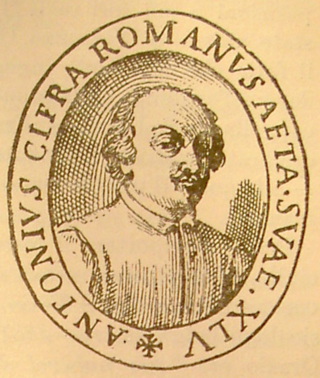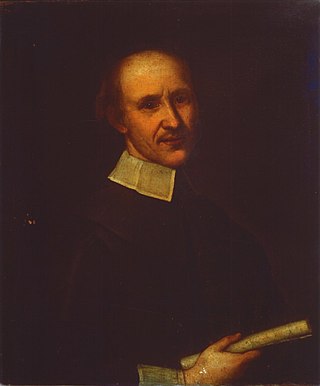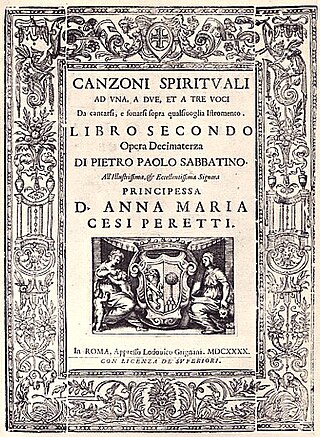Mario Savioni | |
|---|---|
 Portrait of Mario Savioni, engraved by Benedetto Luti | |
| Born | 1608 in Rome |
| Died | 22 April 1685 |
Mario Savioni (born 1608 in Rome, died 22 April 1685) was an Italian composer and a male alto of the Baroque era.
Mario Savioni | |
|---|---|
 Portrait of Mario Savioni, engraved by Benedetto Luti | |
| Born | 1608 in Rome |
| Died | 22 April 1685 |
Mario Savioni (born 1608 in Rome, died 22 April 1685) was an Italian composer and a male alto of the Baroque era.
Savioni receives training as a choirboy under the direction of Vincenzo Ugolini at San Luigi dei Francesi in Rome from 1617 to 1621. In 1621, he sang as a boy soprano at the Cappella Giulia of St. Peter's Basilica in the Vatican City, and later as an alto in 1626. [1]
In September 1631, he returns to San Luigi dei Francesi to work with Ugolino as his assistant. At San Luigi, he received higher salary than the other singers.
From 1638, he worked with Orazio Benevoli, the Kapellmeister of Cappella Giulia. The collaboration ends in 1644, when he was appointed as the Kapellmeister at San Luigi. Savioni also worked closely with Luigi Rossi, the organist of San Luigi who is also a composer.
On 22 February 1642, Savioni sang the role of Alceste in Rossi's Il Palazzo incantato at Teatro delle Quattro Fontane (Palazzo Barberini). It was during this time that he became closed to Cardinal Antonio Barberini. Recognized by his talent, in the same year, Savioni was accepted into Papal chorus, and in 1659, was appointed as the maestro di cappella. He served there until 1668. [2] [3]
Savioni was one of the most prolific Italian cantata composers during baroque era. His works consist of large-scale cantata with several arias and recitatives. He composed about 180 cantatas, numerous motets, madrigals, Oratorio per ogni tempo and a spiritual opera in three acts, S. Agnese (libretto by Domenico Benigni), which was performed at the Palazzo Pamphilj in 1651. [2]
Luigi Rossi was an Italian Baroque composer. Born in Torremaggiore, a small town near Foggia, in the ancient kingdom of Naples, at an early age he went to Naples where he studied music with the Franco-Flemish composer Jean de Macque, organist of the Santa Casa dell’Annunziata and maestro di cappella to the Spanish viceroy. Rossi later entered the service of the Caetani, dukes of Traetta.

Francesco Soriano was an Italian composer of the Renaissance. He was one of the most skilled members of the Roman School in the first generation after Palestrina.

Antonio Cifra was an Italian composer of the Roman School of the Renaissance and early Baroque eras. He was one of the significant transitional figures between the Renaissance and Baroque styles, and produced music in both idioms.

Giovanni Legrenzi was an Italian composer of opera, vocal and instrumental music, and organist, of the Baroque era. He was one of the most prominent composers in Venice in the late 17th century, and extremely influential in the development of late Baroque idioms across northern Italy.

Pietro Paolo Sabbatino or Sabbatini was an Italian composer, orchestra director and musician, who was born and died in Rome, and worked mainly in his home city. He composed mostly popular songs of his time, such as villanellas, capriccios, canzones and canzonettas, but he also composed religious music works, such as psalms.
Giovanni Valentini was an Italian Baroque composer, poet and keyboard virtuoso. Overshadowed by his contemporaries, Claudio Monteverdi and Heinrich Schütz, Valentini is practically forgotten today, although he occupied one of the most prestigious musical posts of his time. He is best remembered for his innovative usage of asymmetric meters and the fact that he was Johann Kaspar Kerll's first teacher.
Orazio Benevoli or Benevolo, was a Franco-Italian composer of large scaled polychoral sacred choral works of the mid-Baroque era.
Giuseppe Valentini, nicknamed Straccioncino, was an Italian violinist, painter, poet, and composer, though he is known chiefly as a composer of inventive instrumental music.
Domenico Mazzocchi was an Italian Baroque composer of only vocal music, of the generation after Claudio Monteverdi.
Simone Molinaro was a composer of the late Renaissance in Italy. He was especially renowned for his lute music.

Ercole Bernabei was an Italian composer, chapel master and organist.
Giovanni Felice Sances was an Italian singer and a Baroque composer. He was renowned in Europe during his time.

Antonio Brunelli was an Italian composer and theorist of the early Baroque period.
Count Pirro Capacelli Albergati was an Italian aristocrat, and amateur composer.
Vincenzo Ugolini was an Italian composer of the early Baroque era and of the Roman School.
Stefano Fabri was an Italian composer, organist and furthermore he was known to play the trombone. He succeeded Ruggiero Giovanelli as maestro di cappella of the Cappella Giulia at Saint Peter's Basilica in Rome.
Bonaventura Somma was an Italian Romantic composer, conductor and organist.

Bonifazio Graziani was an Italian organist, composer and clergyman in the Baroque period.
Odoardo Ceccarelli was an Italian singer, composer, and writer prominent in the Sistine Chapel Choir and the Barberini court. Described from the beginning of his career as both a tenor and a bass, he created roles in several operas, including Fileno in Michelangelo Rossi's Erminia sul Giordano and Orlando in Luigi Rossi's Il palazzo incantato.
Francesco Beretta was an Italian organist, composer and Kapellmeister and a predecessor of Paolo Lorenzani - a pupil of Orazio Benevoli - at the Cappella Giulia of St. Peter.